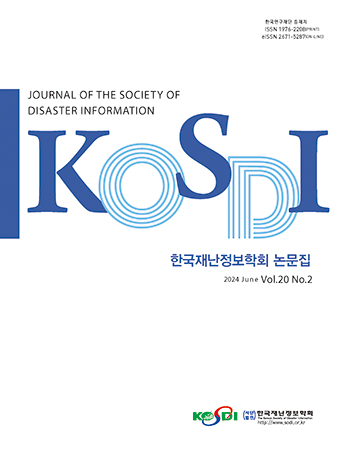Original Article
Abstract
References
Information
Purpose: The purpose of this study is to study how to activate the use of public transportation by identifying the main factors that reduce the use of public transportation due to external influences such as COVID-19 infectious diseases. Method: This study analyzed the connection between the traffic behavior and the characteristics of public transportation use in the metropolitan area changed by COVID-19 with COVID-19 indicators, and analyzed social and environmental factors affecting traffic. Results: It was analyzed that the traffic behavior in the metropolitan area moves from commercial areas to tourist resort areas, the number of COVID-19 deaths affects the use of public transportation, and the lower the deviation between population density, agricultural and forestry areas, and gender ratios due to social and environmental factors, the more significant differences are shown. Conclusion: In the future, it will be able to be activated as a basic analysis model for revitalizing the city's transportation system, regional bases, and various social and economic indicators, such as quarantine of public transportation and social distancing, and can be used as basic data for establishing public transport policy directions according to major influencing factors.
연구목적: 코로나19 감염병 등 외부영향에 따른 대중교통 이용 감소의 주된 요인을 파악하여 대중교통 이용을 활성화 방안을 연구 하는데 목적이 있다. 연구방법: 본 연구는 코로나19로 인해 변화하는 수도권 통행행태와 대중교통 이용 특성을 코로나19 지표와 연계성을 분석하고, 통행에 영향을 미치는 사회⋅환경적 요인을 분석하였다. 연구결과: 수도권 통행행태는 상업지역에서 관광 휴양지역으로 거점이 이동하고, 코로나19 사망자 수 지표가 대중교통 이용에 영향을 주는 것으로 분석되었으며, 사회⋅환경적 요인으로 인구밀도와 농림지역, 남녀 성비가 편차가 낮을수록 유의한 차이를 보임. 결론: 앞으로 교통거점 침 통행행태 변화 분석에 네트워크 중심성 이론을 기반으로 도시의 교통체계와 지역간 거점 및 다양한 사회⋅경제 활성화를 위한 기본 분석 모형으로 활성화 할 수 있을 것이며, 코로나19 지표로 인하여 대중교통이 어떠한 지표에 크게 영향을 받는지 확인할 수 있음에 따라 대중교통 방역 및 사회적 거리 두기 등 다양한 맞춤형 대책 마련하고, 통행량 변화에 따른 사회⋅환경적 요인을 확인할 수 있으며, 주요 영향 요인에 따른 대중교통 정책 방향 수립의 기본 자료로 활용될 수 있다.
- Bhin, M.-y., Son, S.-k., Cho, C.-h. (2021). "An analysis of regional characteristics of change in bus traffic based on the impact of COVID-19." Journal of the Korean Transportation Association, Vol. 39, No. 4, pp. 447-463. 10.7470/jkst.2021.39.4.447
- Chae, S.-j., Jin, J.-i., (2022). "Do people change transportation during COVID-19?: Centering around 2020 Seoul survey citizen survey data." National Territory Planning, Vol. 57, No. 7, pp. 26-40. 10.17208/jkpa.2022.12.57.7.26
- Choo, S.-h., Lee, H.-s., Shin, H.-j. (2013). "Analyzing changes in passing behavior of the elderly using data on household passage in the metropolitan area." National Research, Vol. 76, pp. 31-45. 10.15793/kspr.2013.76..003
- Data Analysis Team, Epidemiological Investigation and Analysis Task Force, Central Disease Control Headquarters, Korea Disease Control and Prevention Agency(KDCA) (2022). "Two-year report of COVID-19 outbreak from January 20, 2020 to January 19, 2022 in the Republic of Korea." Public Health Weekly Report, Vol. 15, No. 7, pp. 414-426.
- Gyeonggi-do Traffic DB Center (2020). Change in the Number of Bus Passengers Before and After COVID-19. Traffic Information Center, Gyeonggi-do.
- Han, K.-h., Kim, D.-k., Kang, W., So J.-h., Lee, C.-k. (2021). "Analyzing the current status and correlation of traffic demand according to COVID-19 indicators." Journal of the Korean ITS Association, Vol. 20, No.6, pp. 55-65. 10.12815/kits.2021.20.6.55
- Incheon Metropolitan City (2021). 2021 Incheon Statistical Yearbook. Incheon.
- Jang, D.-i., Won, M.-g., Jo, J.-s., Choi, J.-m. (2021). A Study on POST COVID-19 Response Strategies by Transportation Sector - Analysis of Traffic Behavior Change and Policy Response -. Korea Transportation Institute.
- Kim, J.-h., Kim, H.-j., Kim, G.-s. (2023). "A study on AI-based predictive models of COVID-19 and changes in the public's choice of transportation." Paper of the Korean Society of Information Technology, Vol. 21, No. 4, pp. 1-9. 10.14801/jkiit.2023.21.4.1
- Lee, S.-h., Kim, J.-s., Kim, M.-s., Woo, Y.-h. (2013). "A study on the analysis of transportation selection behavior of public transportation users." Journal of the Korean ITS Association, Vol. 12, No. 1, pp. 147-157. 10.12815/kits.2013.12.1.147
- Moon, D.H. (2023). Analysis of changes in centrality and influencing factors in Seoul before and after COVID-19 . Master Thesis, Gachon University.
- Sung, H.-g. (2020). "Understanding the discriminatory characteristics of the determinants of the choice of commuting means for single-person households through comparison with multi-person households." LHI Journal of Land, Housing, and Urban Couples, Vol. 11, No. 2, pp. 1-14.
- WHO (2021). COVID-19 Weekly Report. Swiss.
- Yue, H., Will, B., Samantha, S., Dan, W. (2020). "Impacts of COVID-19 mode shift on road traffic." arXiv2005.01610.
- Publisher :The Korean Society of Disaster Information
- Publisher(Ko) :한국재난정보학회
- Journal Title :Journal of the Society of Disaster Information
- Journal Title(Ko) :한국재난정보학회논문집
- Volume : 20
- No :1
- Pages :222-231
- DOI :https://doi.org/10.15683/kosdi.2024.3.31.222




 Journal of the Society of Disaster Information
Journal of the Society of Disaster Information







